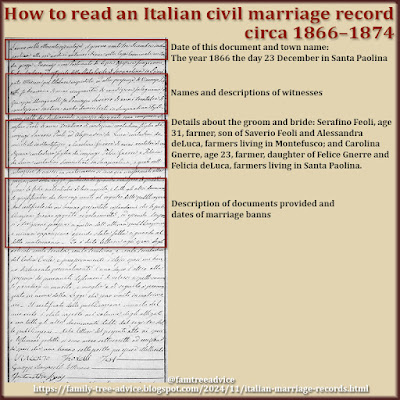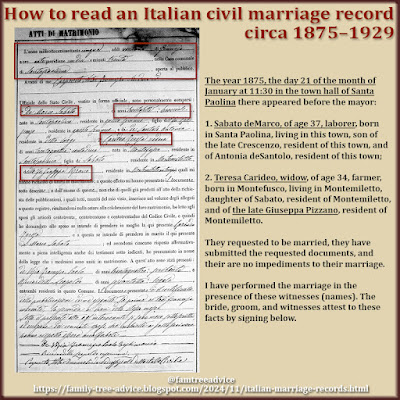This is the third and last in a series of articles revising my February 2017 look at Italian vital records. Today we'll dissect Italian marriage records so you can:
- Find the important details you need for your family tree, and
- Overcome any language barrier.
Italian marriage records include:
- Two dates, usually a week apart, when the couple publicly posted their intention to marry. These are the marriage banns. Today's equivalent is the "speak now or forever hold your peace" statement.
- A third date when the banns are complete and the couple receives permission to marry.
- The groom and bride's basic information.
- The date on which the mayor married the couple.
- The date on which the couple married in the church. A small number of couples will not have a church wedding. The church wedding may be the same day as the civil wedding or it may be sometime later.
The look of the marriage records changed over time, but the main details are the same. Each marriage record boils down to this:
On this date, two people came to city hall to ask the mayor to marry them before witnesses. The document spells out the groom and bride's:
- names
- ages
- professions
- places of birth and/or residence, and
- their parents' names.
This article divides Italian marriage records into six phases based on their layout. Each phase spans several years.
For each type of Italian marriage record below, you'll find a simple version of the wording used. Then you'll see an image highlighting certain key facts. The words for names, ages, dates, and professions are handwritten on the documents. Other phrases are usually pre-printed. It's the handwritten words that are critical to your family tree.
Phase One Civil Marriage Records, Circa 1809–1819
The exact layout of the pre-printed sections varies, but the basic layout is the same.
Simple version: On this date and hour there appeared before me, the mayor of this town, the following people. This man of this age and profession, living in this place, son of this father and mother who give their consent. And also this woman of this age and profession, living in this place, daughter of this father and mother who give their consent. They requested to be married, and they have completed the publication of their intention to marry. I declare them to be united in matrimony in the presence of these witnesses (name, age, profession, residence). The bride, groom, and witnesses attest to these facts by signing below.
 |
| The earliest Italian marriage records have a lot of handwritten sections, but the format is straightforward. |
Phase Two Civil Marriage Records, Circa 1820–1853
This phase introduces a second column where the parish priest records the date of the church wedding. The main part of the marriage record follows the same pattern as Phase One above.
Simple version of the marriage column: On this date in this parish, the parish priest certifies that the celebration of matrimony took place on this date in the presence of these witnesses. The mayor attests that he has seen the marriage document.
 |
| This phase of Italian marriage records adds a column for the church wedding. Pay attention to its format. |
Phase Three Civil Marriage Records, Circa 1854–1865
Depending on the town, the marriage records for this phase may cover two pages. Page two uses a lot of space to provide details about four witnesses to the church wedding. Each of the four lines is as follows:
Simple version: This man, of this age, of this profession, resident of this town and street.
Example: Eduardo delGrosso of the age 40 of the profession lawyer, resident of Colle, street Piazza.
 |
| Two-page Italian marriage records give you details about 4 witnesses, but the main format is the same. |
Phase Four Civil Marriage Records, Circa 1866–1874
Ah, the dreaded fully-handwritten marriage records. But you're prepared. Because you're learning the basic format of Italian marriage records, you CAN find what you need.
Simple version: The year, the day of the month at this hour in the city hall of this town there appeared before the mayor the following people. These witnesses (name, age, profession) who live in this town. Groom, of age, profession, living in this town, son of this father and of this mother, residents of this town. Bride, of age, profession, living in this town, daughter of this father and of this mother, residents of this town. They requested to be married, they have submitted the requested documents, and their are no impediments to their marriage. I, the mayor, have performed the marriage. The bride, groom, and witnesses attest to these facts by signing below.
 |
| Fully handwritten Italian marriage records can be daunting until you realize the format is the same as always. |
Phase Five Civil Marriage Records, Circa 1875–1929
This phase is an easy-to-read single page without a lot of handwriting. There may be no mention of the church wedding. Notice how the basic format is the same as all the previous phases. Only the layout has changed.
Simple version: The year, the day of the month at this hour before the mayor of the town appeared the following people. 1. Groom, of age, profession, born in this town, living in this town, son of this father, resident of this town, and of this mother, resident of this town; 2. Bride, of age, profession, born in this town, living in this town, daughter of this father, resident of this town, and of this mother, resident of this town. They requested to be married, they have submitted the requested documents, and there are no impediments to their marriage. I, the mayor, have performed the marriage in the presence of these witnesses (names). The bride, groom, and witnesses attest to these facts by signing below.
 |
| Later Italian marriage records are the easiest to read, and the important details are at the top. |
Phase Six Civil Marriage Records, Circa 1930–1951
This phase is very much like the previous phase, but it adds one fact. It mentions the church wedding in the column and above the couple's names in the body of the document. It may present the groom and bride's information in two columns. Beneath their details are the dates on which they published their intention to marry.
Simple version: The year, the day of the month at this hour the mayor of the town has learned that on this year, date, month, and hour in this parish, the following people were married according to Catholic rites. 1. Groom, of age, profession, born in this town, living in this town, of this race and this nationality, son of this father and of this mother; 2. Bride, of age, profession, born in this town, living in this town, of this race and this nationality, daughter of this father and of this mother. The couple are officially married. They published their intention to marry on these dates.
And in the column beneath their names: Today, day, month, year, this representative of the church submits the record of this marriage.
 |
| The latest available Italian marriage records include the church name and wedding date. |
When you know what to look for and where to find it, you can get what you need from Italian marriage records.
In case you missed these companion articles:










